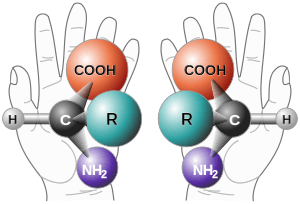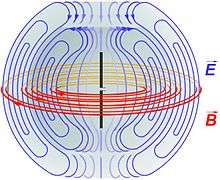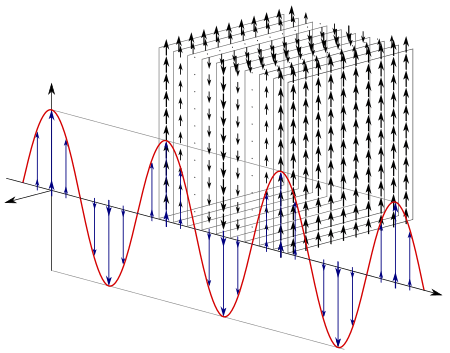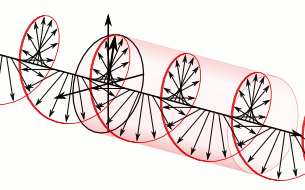Chirality (electromagnetism)


The term chiral /ˈkaɪərəl/ describes an object, especially a molecule, which has or produces a non-superposable mirror image of itself. In chemistry, such a molecule is called an enantiomer or is said to exhibit chirality or enantiomerism. The term "chiral" comes from the Greek word for the human hand, which itself exhibits such non-superimposeability of the left hand precisely over the right. Due to the opposition of the fingers and thumbs, no matter how the two hands are oriented, it is impossible for both hands to exactly coincide.[1] Helices, chiral characteristics (properties), chiral media,[2] order, and symmetry all relate to the concept of left- and right-handedness.[3][4]
Wave propagation as handedness



Electromagnetic wave propagation as handedness is wave polarization and described in terms of helicity (occurs as a helix). Polarization of an electromagnetic wave is the property that describes the orientation, i.e., the time-varying, direction (vector), and amplitude of the electric field vector. For a depiction, see the adjacent image.
In the image, it can be seen that polarizations are described in terms of the figures traced as a function of time all along the electric field vector. A representation of the electric field, as a vector, is placed onto a fixed plane in space. The plane is perpendicular to the direction of propagation.
In general, polarization is elliptical and is traced in a clockwise or counterclockwise sense, as viewed in the direction of propagation. If, however, the major and minor axes of the ellipse are equal, then the polarization is said to be circular . If the minor axis of the ellipse is zero, the polarization is said to be linear . Rotation of the electric vector in a clockwise sense is designated right-hand polarization, and rotation in a counterclockwise sense is designated left-hand polarization
Mathematically, an elliptically polarized wave may be described as the vector sum of two waves of equal wavelength but unequal amplitude, and in quadrature (having their respective electric vectors at right angles and π/2 radians out of phase).[5][6]
Circular polarization

Circular polarization, regarding electromagnetic wave propagation, is polarization such that the tip of the electric field vector describes a helix. The magnitude of the electric field vector is constant. The projection of the tip of the electric field vector upon any fixed plane intersecting, and normal to, the direction of propagation, describes a circle. A circularly polarized wave may be resolved into two linearly polarized waves in phase quadrature with their planes of polarization at right angles to each other. Circular polarization may be referred to as "right-hand" or "left-hand," depending on whether the helix describes the thread of a right-hand or left-hand screw, respectively[7]
![]() This article incorporates public domain material from the General Services Administration document "Federal Standard 1037C". in support of the series on U.S. military standards relating to telecommunications, MIL-STD-188
This article incorporates public domain material from the General Services Administration document "Federal Standard 1037C". in support of the series on U.S. military standards relating to telecommunications, MIL-STD-188
Optical activity
Chiral material presents optical activity. Optical activity is usually very weak in the chiral material found in nature, but it can be enhanced in an artificial chiral material, i.e., chiral metamaterial. In a chiral metamaterial, aligned electric- and magnetic-dipole pairs are induced. The strong coupling between electric and magnetic dipoles results in large optical activity so that the chiral metamaterial can be used for circular polarizer design.[8]
Circular dichroism
Types of chiral materials
Handedness is necessarily intrinsic to chiral materials. Handedness is manifest in the microstructure of homogeneous/homogenizable chiral materials. For example, an isotropic chiral material comprises a random dispersion of handed molecules or inclusions. In contrast, handedness is manifest at the macroscopic level in structurally chiral materials. For example, the molecules of cholesteric liquid crystals are randomly positioned but macroscopically they exhibit a helicoidal orientational order. Other examples of structurally chiral materials can be fabricated either as stacks of uniaxial laminas or using sculptured thin films. Remarkably, artificial examples of both types of chiral materials were produced by J. C. Bose more than 11 decades ago.[9]
Parenthetically, a third type of chiral material has recently entered scientific literature. Such a material is made by depositing spirals (and similar objects) on some flat surface. Spirals, being essentially two-dimensional objects, cannot be chiral, and planar chirality is an infelicitous term that ought to be replaced by a meaningful term.
Repulsive Casimir force in chiral metamaterials
Casimir forces observed experimentally in nature have almost always been attractive and have rendered nanoscale and microscale machines inoperable by causing their moving parts to permanently stick together. This has been a long-standing problem that some researchers have tried to solve.
Nanoscale machines expected to have wide application in industry, energy, medicine and other fields may someday operate far more efficiently thanks to important theoretical discoveries concerning the manipulation of famous Casimir forces that took place at the U.S. Department of Energy's Ames Laboratory.
The ground breaking research, conducted through mathematical simulations, revealed the possibility of a new class of materials able to exert a repulsive force when they are placed in extremely close proximity to each other. The repulsive force, which harnesses a quantum phenomenon known as the Casimir effect, may someday allow nanoscale machines to overcome mechanical friction.
Though the frictional forces in nanoscale environments are small, they significantly inhibit the function of the tiny devices designed to operate in that realm, explained Costas Soukoulis, a senior physicist at the Ames Lab and Distinguished Professor of physics at Iowa State University, who led the research effort.
Soukoulis and his teammates, including Ames Laboratory assistant scientist Thomas Koschny, were the first to study the use of exotic materials known as chiral metamaterials as a way to harness the Casimir effect. Their efforts have demonstrated that it is indeed possible to manipulate the Casimir force. The findings were published in the Sept. 4, 2009 issue of Physical Review Letters, in an article entitled, "Repulsive Casimir Force in Chiral Metamaterials." This work was however discredited because it was based on an unphysical model of the chiral materials (see comment published on the PRL article).
Understanding the importance of their discovery requires a basic understanding of both the Casimir effect and the unique nature of chiral metamaterials.
The Casimir effect was named after Dutch physicist Hendrik Casimir, who postulated its existence in 1948. Using quantum theory, Casimir predicted that energy should exist even in a vacuum, which can give rise to forces acting on the bodies brought into close proximity of each other. For the simple case of two parallel plates, he postulated that the energy density inside the gap should decrease as the size of the gap decreases, also meaning work must be done to pull the plates apart. Alternatively, an attractive force that pushes the plates closer together can be said to exist.
Remarkably, this new discovery demonstrates that a repulsive Casimir effect is possible using chiral metamaterials. Chiral materials share an interesting characteristic: their molecular structure prevents them from being superimposed over a reverse copy of themselves, in the same way a human hand cannot fit perfectly atop a reverse image of itself. Chiral materials are fairly common in nature. The sugar molecule (sucrose) is one example. However, natural chiral materials are incapable of producing a repulsive Casimir effect that is strong enough to be of practical use.
For that reason, the group turned its attention to chiral metamaterials, so named because they do not exist in nature and must instead be made in the lab. The fact that they are artificial gives them a unique advantage, commented Koschny. "With natural materials you have to take what nature gives you; with metamaterials, you can create a material to exactly meet your requirements," he said.
The chiral metamaterials the researchers focused on have a unique geometric structure that enabled them to change the nature of energy waves, such as those located in the gap between the two closely positioned plates, causing those waves to exert a repulsive Casimir force.
The present study was carried out using mathematical simulations because of the difficulties involved in fabricating these materials with semiconductor lithographic techniques. While more work needs to be done to determine if chiral materials can induce a repulsive Casimir force strong enough to overcome friction in nanoscale devices, practical applications of the Casimir effect are already under close study at other DOE facilities, including Los Alamos and Sandia National Laboratories. Both have expressed considerable interest in using the chiral metamaterials designed at Ames Laboratory to fabricate new structures and reduce the attractive Casimir force, and possibly to obtain a repulsive Casimir force.[10][11]
![]() This article incorporates public domain material from websites or documents of the United States Department of Energy.
from Ames Laboratory
This article incorporates public domain material from websites or documents of the United States Department of Energy.
from Ames Laboratory
See also
References
- ↑ Prelog, Vladmir (1975-12-12). Chirality in Chemistry (PDF). Nobel Lecture. Zürich, Switzerland: ETH, Laboratory of Organic Chemistry. pp. 203–204. Retrieved 2009-08-20.
- ↑ Lakhtakia, Akhlesh (1994). Beltrami Fields in Chiral Media. Nobel Lecture. Singapore: World Scientific.
- ↑ Zouhdi, Saïd; Ari Sihvola; Alexey P. Vinogradov (2008-12). Metamaterials and Plasmonics: Fundamentals, Modelling, Applications. New York: Springer-Verlag. pp. 3–10, Chap. 3, 106. ISBN 978-1-4020-9406-4. Check date values in:
|date=(help) - ↑ Note: For more discussion regarding wave propagation and handedness see: Talk:Polarizer/Lengthy quotes
- ↑ Description of Polarization. Federal Standard-1037C. Aug 23 2000. Accessed on 2010-06-28.
- ↑ Wavelength is the distance between points of corresponding phase of two consecutive cycles of a wave. The wavelength, is related to the propagation velocity, v , and the frequency, f , by = v /f . Federal Standard-1037C Aug 23, 2000. Accessed on 2010-06-28
- ↑ "circular polarization". Telecommunications: Glossary of Telecommunication Terms. Institute for Telecommunication Sciences and National Communications System. August 23, 2000. Archived from the original (Federal Standard 1037C) on 2011-03-11. Retrieved 2010-07-01.
- ↑ Chen, Menglin L. N.; Jiang, Li Jun; Sha, Wei E. I.; Choy, Wallace C. H.; Itoh, Tatsuo (2016-08-16). "Polarization Control by Using Anisotropic 3-D Chiral Structures". IEEE Trans. Antennas Propagat. 64 (11): 4687–4674. doi:10.1109/TAP.2016.2600758.
- ↑ T.G. Mackay and A. Lakhtakia (2010). "Negatively refracting chiral metamaterials: a review". SPIE Rev. 1: 018003. Bibcode:2010SPIER...1a8003M. doi:10.1117/6.0000003.
- ↑ Soukoulis, Costas (Senior Physicist); Ingebretsen (Contact), Mark (December 7, 2009). "Metamaterials could reduce friction in nanomachines". Ames Laboratory. Archived from the original (Research team has a new application for metamaterials that has potential to eliminate mechanical friction in nanotechnology) on May 4, 2010. Retrieved 2006-10-20. Ames Laboratory is a U.S. Department of Energy Office of Science research facility operated by Iowa State University.
- ↑ Soukoulis, Costas (Senior Physicist); Ingebretsen (Contact), Mark (December 7, 2009). "Metamaterials could reduce friction in nanomachines" (Copyright info here.). Eureka Alert -Ames Laboratory press release. Retrieved 2006-10-20. Ames Laboratory is a U.S. Department of Energy Office of Science research facility operated by Iowa State University.
Further reading
- Lakhtakia, Akhlesh (1990). Selected Papers on Natural Optical Activity. SPIE Optical Engineering Press.
- Wagniere, Georges H. (August 2007). On Chirality and the Universal Asymmetry: Reflections on Image and Mirror Image. Wiley, John & Sons. pp. Chapter 3, page 49. ISBN 978-3-906390-38-3. Chapter title: Light, Magnetism, Chirality .
External links
- Mullen, Leslie, Science Communications (May 9, 2001). "Life's Baby Steps (Chirality)" ("Billions of years ago, amino acids somehow linked together to form chainlike molecules".). NASA Astrobiology Institute. Retrieved 2010-06-28.
- Ames Laboratory. Press release archives. accessed:2010-06-28.